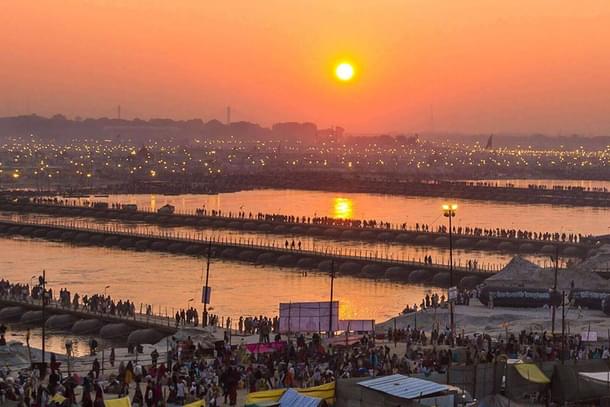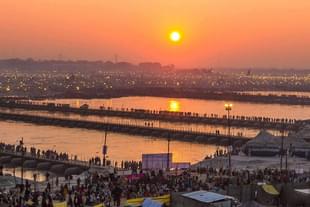Culture
Maha Kumbh Mela Part-2: Prayagraj
Venu Gopal Narayanan
Mar 08, 2025, 10:00 AM | Updated Mar 07, 2025, 11:19 PM IST
Save & read from anywhere!
Bookmark stories for easy access on any device or the Swarajya app.


Prayagraj is the ultimate equalizer, in more ways than one, when a Maha Kumbh Mela is held there once every 144 years. In 2025, even when modes of transport are far more than what were available when the Kumbh was last held there in 1882, and whether the countless pilgrims arrive by bus, train, plane, motorcycle, or car, their progress comes to a grinding halt in the city.
The approaches to the bathing ghats at Triveni Sangam, the sacred confluence of the Ganga, the Yamuna, and the Saraswati, from whichever direction, are quite simply incapable of absorbing such a massive, and continuous, influx.
It is not a matter of the number of roads or traffic lanes, or of dedicated flyovers or elevated roads, but of the sheer mortal incapacity to ever be able to handle such a large number of pilgrims who are converging onto the very same spot, at the same time.
As a result, swanky luxury SUVs growl patiently in queue with the rest of the vehicular spectrum. Many park at great distances and take to foot. Surprisingly, there is no road rage; everyone is resigned to the inevitable rigors of such an epochal assemblage – one which, as the media never tires of repeating, has no parallel in human history.
Might have taken a boat into town, a weary wag grins ruefully. Yet, alas, the month of the Kumbh is not very conducive to riparian transport, since the snowmelt is still on a cusp.
They come from everywhere, from literally every corner of the subcontinent, and in the modern age, from wherever the Indian diaspora has reached across the world.
Every step, every mile towards the holy waters, reinforces the sacred geography of this land like nothing else every could. Ancient Prayagraj, a periodic spiritual epicentre, exactly as it has been for millennia, and as it will be for as long as the waters hold their course.
This writer’s intended destination is the Juna Akhada, but the traffic snarls put paid to that grand plan. So, instead, a detour is sought to the Arial Ghat, on the south bank of the confluence.
It is tough going, not least because Google Maps’ routing algorithms have conceded defeat. A path query returns absurd results, like deviating to Mirzapur, crossing the Ganga halfway to Varanasi, and taking the Aurai-Saidabad road back into Prayagraj. Great advice, surely, save for the fact that the algorithm appears incapable of comprehending another issue at hand: that, getting out of town is almost as difficult as getting in!
Eventually, though, after six trying hours of kerbside crawling, interspersed with futile efforts to beat the rush via tiny alleyways, and a hair-raising cross-country dash across an open field (worthy of applause from the Armoured Corps), you arrive after midnight at a sprawling parking lot a kilometre from the Ghat.
The uniformed constabulary stand to in flocks, directing traffic, and patiently providing answers to pilgrims’ queries. It is a big relief, a panacea for the lack of signage, and a remarkable contrast from the stereotypes of surly, roguish, paan-chewing Eastern UP types who speak an incomprehensible brogue, which the rest of the country has been unfairly fed by cinema and television for some decades now.
To one side, families spread large plastic sheets on which to lay out their bed rolls. There, a large family is already asleep, covered from head to toe in colourful blankets. And here, a dozen-strong contingent, Bengali by the looks of it, tuck into a well-earned dinner before turning in.
Somewhere in the distance, a baby whimpers uncomfortably. In echo rises its mother’s soothing hush. Once more, a muted wail, and then there is silence. It is the last thing one would expect at such a large gathering, and yet, it is also the first thing that strikes you. The silence.
So unexpected. Unnerving, in fact. Indeed, for a race as voluble as ours, this quietude is anachronistic. Perhaps it is the overweening solemnity of the moment which forces voices into a hush. Or, perhaps, this is who we were, and are slowly becoming again: a noble race, accustomed to deep manners, and a collective behaviour gradually being governed once more, now, by stoic rectitude, forbearance, and deference.
From the looks of it, the majority who are arriving through the night will rest for a while before going to the ghats. Yes, by two in the night, the flow of vehicles into the parking lots has reduced (of course, this is only relative, but the lull is palpable). Accordingly, a spot decision is taken that this writer’s band shall proceed post haste to the nearest ghat. No doubt, the monks and sadhus at the Juna Akhada would be disappointed that we were unable to join them for the night’s repast, but it is what it is.
The lights of the Yamuna Bridge show the way, a towering structure which stretches across the river in imposing suspension. And as you approach the bridge at ground level, it appears to grow even taller. Closer, step after step along the dusty sloping banks, and you realize that it is teeming with long columns of pilgrims either crossing south to the ghats, or walking north to other sectors closer to Triveni Sangam. So many people. An endless row of constant, Brownian motion. And again, the palpable lack of babble, hurry or rush.
It is no different on the approach to the Arial Ghat, where pilgrims board electric auto rickshaws, to zip in a muffled whine for a few minutes, or walk the last mile. Luckily, the anticipated cold wave has passed the Kumbh by. The weather is pleasant. The air smells clean. So different from the stench, noise, and unruliness one expected.
The ghats are well lit, with metal scaffolding and barriers to prevent stampedes. The south bank is full of people, for as far as the eye can see. Across the waters, lamps line the horizon in an endless glow, merging in the distance into one curving line, like the condensation of countless stars in a galaxy’s spiral. And mind you, this is perhaps no more than a tenth of the entire riverside stretch prepared to receive millions upon millions of pilgrims. What scale of pious assemblage! Nothing else on this planet comes close by even two or three orders of magnitude.
At the waterfront stand lines of changing rooms. The urge to take in the sights, to try and truly absorb the atmosphere, recedes with the motions of preparation for the dip.
While the others of his band change, this writer starts chanting the names and birth stars of those near and dear, both alive and no more. There is a lot of squinting into a cell phone to read the lists sent at the very last minute, some frowning of the brows at futile efforts to translate birth star names from Kannada and Marathi into Malayalam. But the task is successfully completed at last. Prayers for ancestors, family, friends, and generations yet to come, because sentient life is nothing more than thoughts and actions of the right sort, which seek to uphold the natural order of things. That is Dharma.
You step into the water gingerly, expecting to find muck, but there is none; only fine silt. You say your prayers. You wade into the water up to your waist. Then you take the dip. You lift the water up in your hands and let it flow back to whence it came. You note that the water is crystal clear. Ah… the incorrigible habit of a writer to observe all things, everything, all the time, even when making a sacred offering. You do it again, this time with focused concentration. You sigh.
The mind is at peace. A mild breeze softly caresses your shoulders, but not so cool that it forces a shudder. No, the atmosphere is perfect, as perfect as it should be every 144 years. You sigh again, and return to the banks. There is no rush to change. Let the others of your band go first. And when they are done, you put on your dry clothes, like the skin of a new life, which it actually is.
Whatever you have done up to this point is now in the past. From here on, there is just a heightened desire to try and lead a better life, to be a better parent, a better friend, if you can, without seeking any transactional recompense of any sort, be it material or emotional, or even spiritual. To try and be more selfless. Will the myriad vicissitudes or vagaries of life allow that? Who can tell? All you can do is try.
And with that, another decision is taken, to depart during the late-night lull (or is it now early morning?). Practicalities; always practicalities, the bridge linking thought to action – even at such a spiritually overwhelming spot as this sacred confluence.
The slow drive out of Prayagraj begins, along empty exits which hours before had been packed with vehicles. You wonder why you aren’t feeling sleepy. Where on earth is the fatigue which should have hit you at this odd hour, deprived of sleep after driving for three days? There is no point searching for an answer, you conclude, as the road starts to climb back up to the Malwa plateau and the Vindhyan knot.
It is the way of the pilgrim, and that is answer enough, for your actions through life up to this point, and for whatever lies ahead. Godspeed.
Venu Gopal Narayanan is an independent upstream petroleum consultant who focuses on energy, geopolitics, current affairs and electoral arithmetic. He tweets at @ideorogue.





